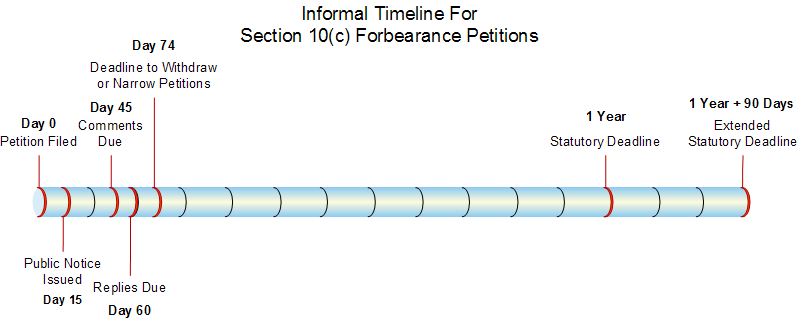
The timeline is intended to promote transparency and predictability in the Commission’s process for addressing forbearance petitions. As with any general timeline, it necessarily oversimplifies the process. Most of the dates and time ranges in the timeline are approximate, and the circumstances of individual petitions may require different time frames for particular parts of the process.
Prefiling
In the Forbearance Procedures Order, the Commission adopted a “complete as filed” rule, which is codified at 47 C.F.R. § 1.54. That rule sets forth requirements a forbearance petition must meet in order to be considered on its merits. A party planning to file a forbearance petition also may wish to contact the Commission staff prior to filing.
Day 0: A Forbearance Petition Is Filed
In addition to specifying requirements for the contents of forbearance petitions, the “complete as filed” rule requires a forbearance petitioner to email a copy of its petition to forbearance@fcc.gov at the time it is filed. The purpose of this requirement is to alert key Commission staff of each forbearance petition as soon as it is filed, helping to ensure expeditious consideration.
Days 1-15: Initial Review by Commission Staff
The Commission staff’s initial review of a forbearance petition takes place during the days immediately following its filing. The purpose of this review is to determine whether the petition is complete, coherent, and sufficiently specific to serve as a basis for public comment. A petition that is incomplete or defective on its face, or otherwise does not comply with the "complete as filed" rule will be summarily denied.
Summary denial at the beginning of a forbearance proceeding gives the petitioner an early opportunity to cure and refile, and respects interested parties’ resources. A failure to summarily deny a petition upon receipt is not a final determination that the petition complies with the “complete as filed” rule.
Day 15: Public Notice and Protective Orders
If a forbearance petition appears to be complete and coherent on its face, Commission staff will release a public notice inviting public comment on the petition, and setting comment and reply comment deadlines.
Commission staff also will issue protective orders in appropriate cases. These orders provide protection against the unwarranted disclosure of confidential information that parties have submitted to the record in forbearance proceedings.
Days 45 and 60: Deadlines for Filing Comments and Reply Comments
Typically, the public notice will allow about 30 days for comments and 15 days for replies, with longer pleading cycles for more complex petitions. The public notice will provide information on how to file comments and replies.
A party also may file a motion asking the Commission to summarily deny a petition for forbearance. This motion is due not later than the due date for comments. The petitioner may file an opposition to a motion for summary denial not later than the due date for replies. The Commission does not permit replies to oppositions to motions for summary denial.
Day 74: Deadline for Withdrawing or Significantly Narrowing a Forbearance Petition
The Commission’s rules permit a petitioner to withdraw or narrow a forbearance petition at any time during the early stages of a forbearance proceeding. Later in the proceeding, however, the petitioner must receive Commission authorization prior to withdrawing or substantially narrowing the petition. The deadline for unilateral withdrawal or narrowing without Commission approval is the reply comment deadline plus 10 business days.
Day 75 – Month 10: Intermediate Period
During this intermediate period, Commission staff will analyze the record developed in response to the public notice and any motions for summary denial. The Bureau will consider whether to grant or deny routine or less complex forbearance petitions. For instance, in some circumstances, the record will make clear that a forbearance petition clearly meets, or clearly fails to meet, the statutory forbearance criteria. In the Forbearance Procedures Order, the Commission anticipated that such petitions would be resolved within six months of their filing.
More complex petitions typically will require additional time to resolve. This additional time will be spent analyzing any data that the parties have filed and, where appropriate, actively developing the record, among other tasks.
In appropriate circumstances, the staff will issue an order extending the deadline for Commission action on a forbearance petition by up to 90 days.
Month 11 – Statutory Deadline: Final Period
The final period will consist generally of months 11 and 12 in normal cases, or months 14 and 15 if the Commission extends the statutory deadline. In the Forbearance Procedures Order, the Commission adopted several rules to govern this final period. These rules help ensure that the Commissioners will be able to make the necessary determinations and release an order prior to the statutory deadline.
Circulation (four weeks before deadline). The first of these rules imposes a deadline for circulation of a draft order to the FCC Commissioners. The Commission’s rules permit subordinate officials, such as a Bureau Chief, to act on some matters pursuant to delegated authority. When a forbearance petition presents novel questions of fact, law or policy that the staff cannot resolve under existing precedent and decisions, however, the Commission’s Chairman circulates an order addressing the petition to all the Commissioners for their consideration. In the Forbearance Procedures Order, the Commission required that this circulation occur no later than 28 days prior to the statutory deadline, unless all Commissioners agree to a shorter period.
Quiet Period (two weeks before deadline). In the Forbearance Procedures Order, the Commission established a two-week quiet period before the statutory deadline (one week before the voting deadline) during which ex parte contacts are prohibited. This rule creates a period of Commission deliberation free from outside lobbying as the voting and statutory deadlines approach.
Voting Deadline (one week before statutory deadline). In the Forbearance Procedures Order, the Commission also required that the Commissioners vote on any circulated order resolving a forbearance petition no later than seven days prior to the statutory deadline for acting on the petition.